

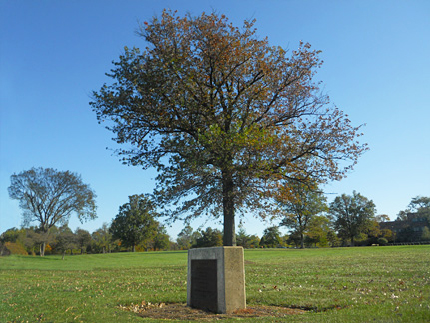
Washington Route Marker
Finderne Ave. near Van Veghten Dr.
Map / Directions to this Washington Route Marker
Map / Directions to all Bridgewater Revolutionary War Sites
Following their victory at the Battle of Princeton on January 3, 1777, General George Washington and his army went to Morristown for winter quarters, where they arrived on January 6. This marker is the fourth of a series of thirteen showing the route taken by Washington's army from Princeton to Morristown. [1]
The other twelve markers in this series can be found in Princeton, Kingston, Griggstown, Somerville, Bedminster, Bernardsville, Basking Ridge, Harding Township and Morris Township.
For a map tracing the route of all thirteen markers from Princeton to Morristown, click here.

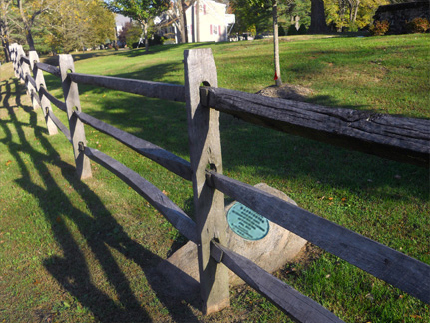
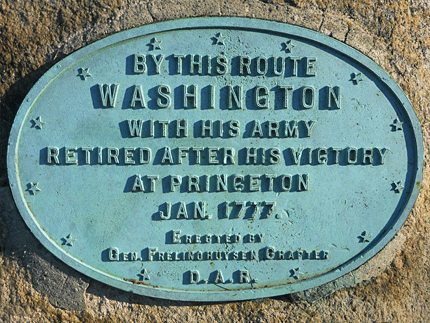
Washington Route Marker
Foothill Rd. and Allen Rd.
Map / Directions to this Washington Route Marker
Map / Directions to all Bridgewater Revolutionary War Sites
This marker is the sixth of the series of thirteen showing the route taken by Washington's army from Princeton to Morristown in January 1777. (See above entry for more details.) This marker is a small boulder plaque which sits behind a wooden rail fence in front of a house on Foothill Road. [2]

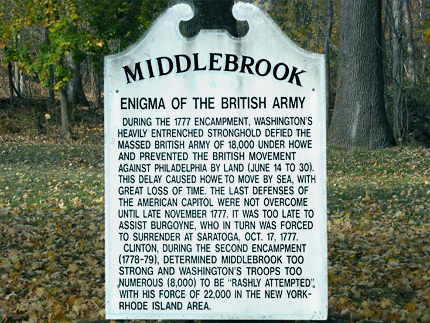
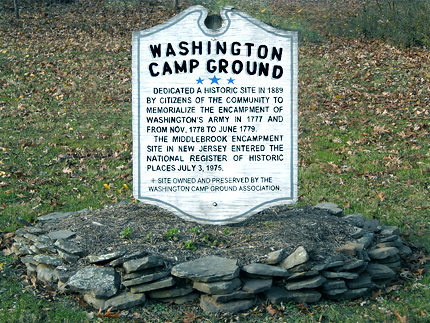
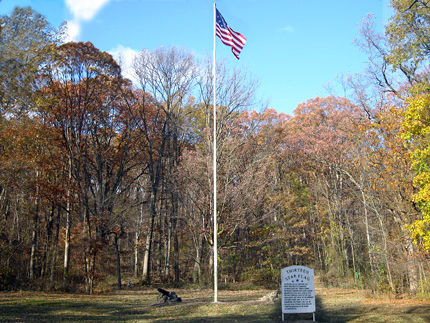
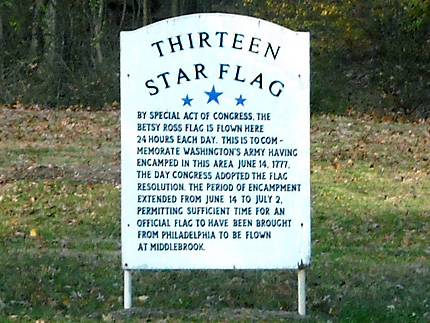
Washington Camp Ground
Middlebrook Encampment Site
Middlebrook Rd. at the intersection of Cedarcrest Rd.
Map / Directions to the Middlebrook Encampment Site
Map / Directions to all Bridgewater Revolutionary War Sites
First Middlebrook Encampment: May 28 - July 2, 1777
Following their victories in the Battles of Trenton and Princeton, Washington's army spent the first several months of 1777 encamped in Morristown. They moved their encampment to this area, which was then known as Middlebrook, on May 28. The Washington Camp Ground covers some of the area they camped on, but portions of the army camped to the west of here, along the slopes on Chimney Rock Road. (A historic marker on Chimney Rock Road near Gilbride Road marks that portion of the encampment.) Three miles to the east, the site of what is now Washington Rock State Park in Green Brook was used as a lookout. [3] In total 8,000 Continental (American) troops were encamped in this area from May 28 - July 2, 1777. During most of the army's encampments, General Washington took up headquarters in a local house. However, during the first Middlebrook Encampment, he made his headquarters in his tent. [4]
Washington was trained as a surveyor as a young man, and had an appreciation and understanding of topography; therefore, he chose his encampment sites well. The Middlebrook Encampment was located along First Watchung Mountain, providing security. It also provided high cliffs for lookouts towards New Brunswick, which was then occupied by British troops under General Cornwallis.
On June 17, 1777, Washington described the security of the Middlebrook Encampment site in a letter to Major-General Benedict Arnold: "The main body of our army is encamped at Middlebrook... The position here is very strong, and with a little labor, which will be bestowed upon it, will be rendered a great deal more so. The passes in the mountains are for the most part extremely difficult, and cannot be attempted with any degree of propriety." [5]
It was during the time of the first Middlebrook Encampment, on June 14, 1777, that the Second Continental Congress, who were then meeting in Philadelphia, passed the Flag Resolution. It stated: "Resolved, That the flag of the thirteen United States be thirteen stripes, alternate red and white; that the union be thirteen stars, white in a blue field, representing a new constellation." [6]
There is a tradition that the first time the Continental Army flew the stars and stripes was at Middlebrook. Because the Middlebrook Encampment lasted until July 2, eighteen days after the Flag Resolution, it is considered likely, but uncertain, that enough time existed for an official flag to have been brought to Middlebrook from Philadelphia. Because of this, a thirteen-star American flag flies here twenty four hours a day, by a special act of Congress. [7]
Second Middlebrook Encampment: November 1778 - June 3, 1779
In the 1700's, armies did not generally fight in the winter, and would take up winter quarters. For the winter of 1778-1779, Washington chose to return to Middlebrook for the army's encampment. Troops began arriving here at the end of November, and continued to arrive over the next weeks. Washington himself would not arrive until December 11; he made his headquarters at the Wallace House in Somerville. Washington and the army remained in Middlebrook well beyond the winter; the encampment remained here until June 3, 1779. However, he did leave the Middlebrook Encampment from December 22 until February 5 to meet with the Continental Congress in Philadelphia. General Lord Stirling was left in command of the Middlebrook Encampment in Washington's absence. [8]
Other American generals were headquartered in various houses in the area. Five of the houses that were used by Generals during the encampment still stand:
• General George Washington - at the Wallace House in Somerville.
• General Henry Knox - at the Jacobus Vanderveer House in Bedminster
• General William Alexander (Lord Stirling) - at the Van Horne house in Bridgewater (See entry lower on this page)
• Quartermaster General Nathanael Greene - at the Van Veghten house in Bridgewater (See entry lower on this page)
• General von Steuben - at the Abraham Staats House in South Bound Brook
The Heritage Trail Association of Somerset County runs a Five Generals Bus Tour in February, which visits all five of these houses.
For more information about this and their other events, see their website www.heritagetrail.org.

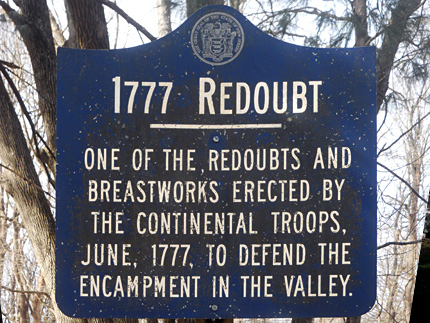
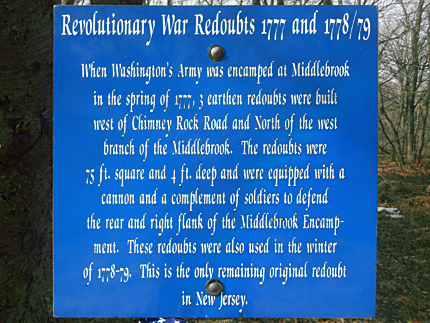
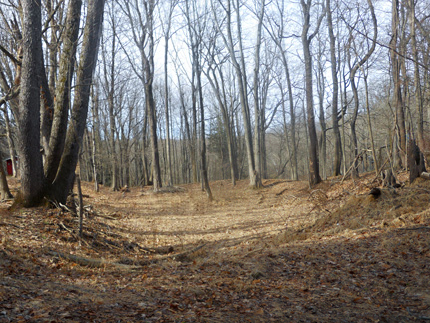
Redoubt
Bolmer Farm Rd.
Map / Directions to the Redoubts
Map / Directions to all Bridgewater Revolutionary War Sites
Redoubts are enclosed defensive forts, usually constructed of soil and earthworks. During the first Middlebrook encampment in 1777, three redoubts were built "west of Chimney Rock Road and North of the west branch of the Middlebrook." During the Second Middlebrook encampment, these redoubts were used again.
The remains of one of the redoubts can still be seen here, although it has worn down and eroded over the past nearly two-and-a-half centuries. It is New Jersey's only surviving Revolutionary War redoubt. Two historic signs at the site describe its history.[9]

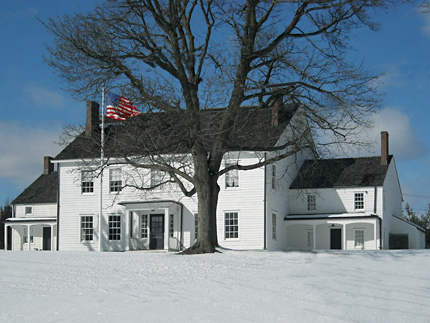
Van Horne House
941 East Main St.
Map / Directions to the Van Horne House
Map / Directions to all Bridgewater Revolutionary War Sites
The Van Horne House is operated by the Heritage Trail Association.
Visit their website for information about tours and upcoming events:
www.heritagetrail.org.
This house was built circa 1755 by Phillip Van Horne. Phillip entertained both American and British officers at this house during the Revolutionary War. [10]
Battle of Bound Brook
April 13, 1777
British forces under General Cornwallis made an attack at this site during the Battle of Bound Brook. American General Benjamin Lincoln was staying at the Van Horne House, and he was caught by surprise by the attack. He managed to escape capture by fleeing the house, apparently before he had time to fully dress in his uniform. Some of the men guarding the house were killed, and their three cannons were captured by the British.[11]
Second Middlebrook Encampment
November 1778 - June 1779
General Lord Stirling used this house as his headquarters during the Second Middlebrook Encampment. Lord Stirling, whose birth name was William Alexander, was born in New York City in 1726. He later moved to Basking Ridge, NJ. Stirling began his Revolutionary War service as a colonel in the Somerset County Militia. He was later appointed Brigadier General and then Major General in the Continental Army. Lord Stirling was a close friend of George Washington, and one of his most trusted Generals.

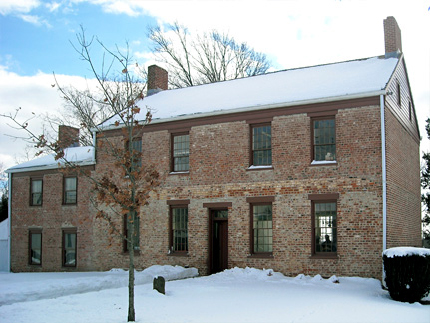
Van Veghten House
9 Van Veghten Rd.
Map / Directions to the Van Veghten House
Map / Directions to all Bridgewater Revolutionary War Sites
The Van Veghten House is operated by the Somerset County Historical Society.
Visit their website for information about tours and upcoming events:
www.schsnj.com
This house was built at this site overlooking the Raritan River circa 1725 by Derrick Van Veghten, a wealthy farmer and prominent local citizen. During the Second Middlebrook Encampment, the house was used as the headquarters for Quartermaster General Nathanael Greene. Van Veghten's property encompassed a thousand acres, running from the Raritan River to the Watchung Mountains; some of the troops camped on his surrounding property. [12]
Greene wrote in a letter of an enjoyable evening spent while headquartered here: "We had a little dance at my quarters a few Evenings past. His Excellency [General Washington] and Mrs. Greene danced upwards of three hours without once siting [sic] down. Upon the whole we had a pretty little frisk." [13]

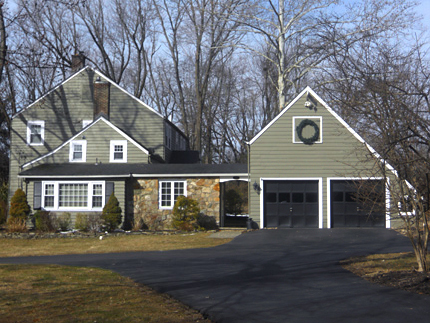
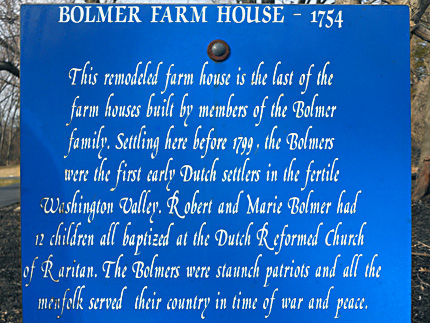
Bolmer Farm House
West Circle Dr.
Map / Directions to the Bolmer Farm House
Map / Directions to all Bridgewater Revolutionary War Sites
This house is a private residence.
Please respect the privacy and property of the owners.

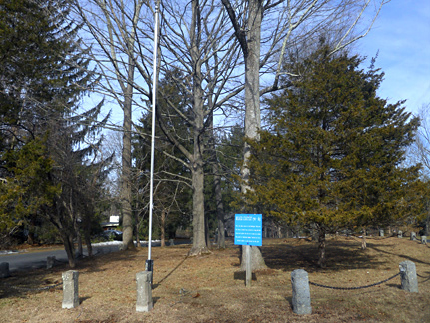
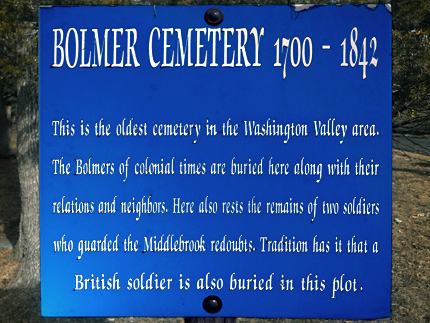
Bolmer Cemetery
Middle Rd.
Map / Directions to the Bolmer Cemetery
Map / Directions to all Bridgewater Revolutionary War Sites

1. ^ This marker was erected by the Camp Middlebrook Chapter of the Daughters of the American Revolution.
• For more details and accompanying source notes about the Battle of Princeton and the 1777 Morristown encampment, see the Princeton and Morristown pages of this website.
2. ^ This marker was erected by the General Frelinghuysen Chapter of the Daughters of the American Revolution.
3. ^ The State of New Jersey Historic Sign located on Chimney Rock Road near Gilbride Road is shown below:
4. ^ George Washington letter to John Augustine Washington, sent from "Camp at Middle brook. June 29th 1777"
Available to be read at the website of the National Archives here.
▸ In this letter to his brother, Washington wrote:
"Finding Genl Howe was Assembling his whole Force (excepting the necessary Garrisons for New York &ca) at Brunswick, in this State, I began to collect mine at this place; (a strong piece of ground) ten Miles distant from him, where I have now been (in my Tent) about 5 Weeks."5. ^ George Washington letter to Major-General Benedict Arnold, sent from Middlebrook, June 17, 1777, reprinted in:
George Washington; Edited by Jared Sparks, The Writings of George Washington Volume 4 (Boston: Russel, Odiorne and Metcalf; and Hilliard, Gray, and Co., 1834) p. 463 - 464
Available to be read at Google Books here6. ^ Worthington Chauncey Ford, Editor, Journals of the Continental Congress, 1774-1789, Volume VIII, May 22 - October 2, 1777 (Washington D.C.: U.S. Government Printing Office, 1907) 463-464
Available to be read at Google Books here7. ^ Thirteen Star Flag sign at the Middlebrook Encampment site.
8. ^ The dates of Washington's arrival and departure from Middlebrook and his trip to Philadelphia are documented in his letters from the time:
• George Washington's arrival in Middlebrook on December 11 is documented in his December 13 letter to the President of Congress:
"... I did not reach this place till late on the 11th, since which I have been much employed in attending to the dispositions for hutting the army; but, in the mean time, the objects of the despatch have engaged my utmost attention."
▸ This letter is reprinted in:
George Washington; Edited by Jared Sparks, The Writings of George Washington Volume VI (Boston: Little, Brown, and Company, 1858) p. 134 Available to be read at Google Books here• George Washington's departure from Middlebrook on June 3 is noted in his letter of that day to the President of Congress:
"We shall press forward with all diligence, and do every thing in our power to disappoint the enemy. I expect to set out this day towards the Highlands by way of Morristown."
▸ This letter is reprinted in:
George Washington; Edited by Jared Sparks, The Writings of George Washington Volume VI (Boston: Little, Brown, and Company, 1858) p. 134, and 267-268 Available to be read at Google Books here• Washington's leaving for Philadelphia, and the passing of command in his absence to Lord Stirling are noted in Washington's letter to Lord Stirling on Monday December 22, 1778:
"Congress having been pleased to require my attendance in Philadelphia for a few days, the immediate command will devolve upon your Lordship."
▸This letter is reprinted in:
George Washington; John C. Fitzpatrick, Editor, The Writings of George Washington from the Original Manuscript Sources / Volume 13 - October 1, 1778 - January 11, 1779 (Washington D.C.: United States Government Printing Office, 1936) p. 443
Available to be read at the Internet Archive here• For Washington's return to Middlebrook from Philadelphia on February 5, see:
George Washington; John C. Fitzpatrick, Editor, The Writings of George Washington from the Original Manuscript Sources / Volume 14 - January 12, 1779 - May 5, 1779 (Washington D.C.: United States Government Printing Office, 1936) Pages 68, 69, and 73
Available to be read at Google Books here9. ^ Two historic signs at the redoubt, one of which is a State of New Jersey historic sign.
10. ^ Van Horne house page of the website of the Heritage Trail Association website, who use the house as their headquarters.
11. ^ Captain Johann Ewald, Translated and edited by Joseph P. Tustin, Diary of the American War - A Hessian Journal (New Haven and London: Yale University Press, 1979) page 56.
▸ Captain Ewald led an attack at the Old Stone Bridge during the Battle. His diary is one of the main sources of information about the Battle of Bound Brook.
The following is Ewald's description of the events that occurred at and around the Van Horne House, and the escape of General Lincoln. Note that Ewald mistakenly believed that General Anthony Wayne was also at the house, which he was not.
"At eleven o'clock in the evening Colonel Harcourt with fifty horse, two light infantry battalions under Colonel Abercromby, and a battalion of English grenadiers under Colonel Meadows crossed the Raritan River below the Van Veghten bridge, and arrived behind [Van] Horne's plantation where generals Lincoln and Wayne lay in their quarters under cover of three 4-pounders [cannons] mounted in the rear of the enemy quarters. The guard was partly cut down and partly captured, the three cannon seized, and the two generals fled without their breeches."
▸ In the source notes of the book, the editor quotes from the Journal of American Officer Ensign Thomas Glyn, "General Lincoln escaped without his clothes, all his papers were seized."
This manuscript, Journal of American Campaign, which I have not read at this time, is available at the Rare Books and Special Collections Manuscripts Collection at Princeton University Library.
12. ^ Information about the house was drawn from:
• The website of the Somerset County Historical Society
• The Somerset County Historic sign in front of the house (erected by the Somerset County Board of Chosen Freeholders 2012)
• George Washington's Middlebrook Encampment 1778-1779 brochure (Produced with grants from the New Jersey Historical Commission, a division of the Department of State.)13. ^ Nathanael Greene letter to Colonel Jeremiah Wadsworth, March 19, 1779, published in:
Nathanael Greene, Edited by Richard K. Showman, Robert E. McCarthy, and Elizabeth C. Stevens, The Papers of General Nathanael Greene / Volume III: 18 October 1778 - 10 May 1779 (Chapel Hill, N.C.: University of North Carolina Press, 1984) pg 354